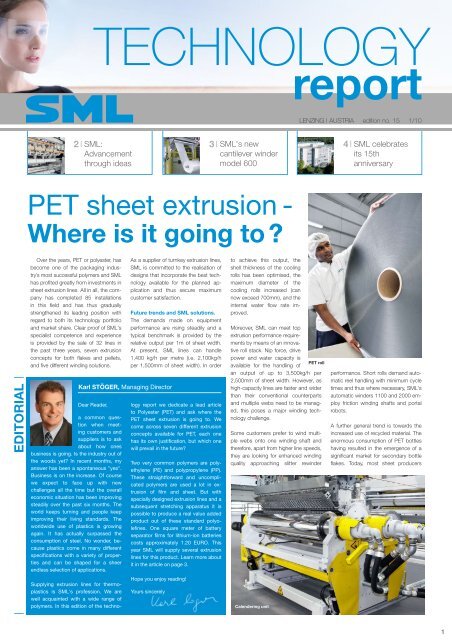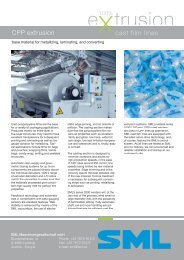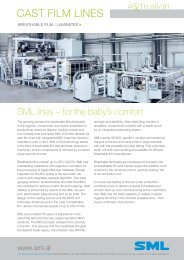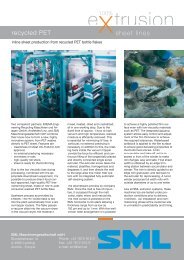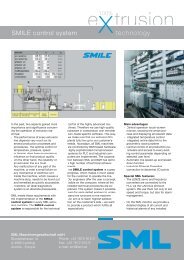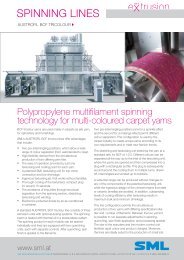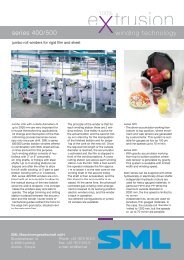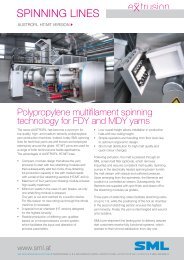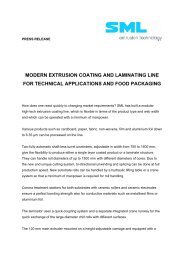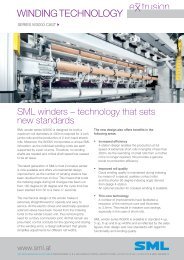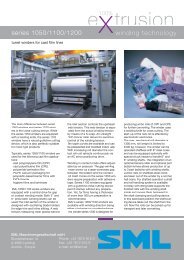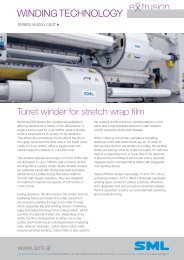You also want an ePaper? Increase the reach of your titles
YUMPU automatically turns print PDFs into web optimized ePapers that Google loves.
2 I <strong>SML</strong>:<br />
3 I<br />
Advancement<br />
through ideas<br />
Over the years, <strong>PET</strong> or polyester, has<br />
become one of the packaging industry’smost<br />
successful polymers and <strong>SML</strong><br />
has profited greatly from investments in<br />
<strong>sheet</strong> <strong>extrusion</strong> lines. All in all, the company<br />
has completed 85 installations<br />
in this field and has thus gradually<br />
strengthened its leading position with<br />
regard toboth its technology portfolio<br />
and market share. Clear proof of <strong>SML</strong>'s<br />
specialist competence and experience<br />
is provided by the sale of 32 lines in<br />
the past three years, seven <strong>extrusion</strong><br />
concepts for both flakes and pellets,<br />
and five different winding solutions.<br />
As asupplier of turnkey <strong>extrusion</strong> lines,<br />
<strong>SML</strong> is committed to the realisation of<br />
designs that incorporate the best technology<br />
available for the planned application<br />
and thus secure maximum<br />
customer satisfaction.<br />
Future trends and <strong>SML</strong> solutions.<br />
The demands made on equipment<br />
performance are rising steadily and a<br />
typical benchmark is provided by the<br />
relative output per 1m of <strong>sheet</strong> width.<br />
At present, <strong>SML</strong> lines can handle<br />
1,400 kg/h per metre (i.e. 2,100kg/h<br />
per 1,500mm of <strong>sheet</strong> width). In order<br />
<strong>SML</strong>'s new<br />
cantilever winder<br />
model 600<br />
<strong>PET</strong> <strong>sheet</strong> <strong>extrusion</strong> -<br />
Where isitgoing to ?<br />
Karl STÖGER, Managing Director<br />
Dear Reader,<br />
a common question<br />
when meeting<br />
customers and<br />
suppliers is to ask<br />
about how ones<br />
business is going. Is the industry out of<br />
the woods yet? In recent months, my<br />
answer has been aspontaneous "yes".<br />
Business is on the increase. Of course<br />
we expect to face up with new<br />
challenges all the time but the overall<br />
economic situation has been improving<br />
steadily over the past six months. The<br />
world keeps turning and people keep<br />
improving their living standards. The<br />
worldwide use of plastics is growing<br />
again. It has actually surpassed the<br />
consumption of steel. No wonder, because<br />
plastics come in many different<br />
specifications with avariety of properties<br />
and can be shaped for a sheer<br />
endless selection of applications.<br />
Supplying <strong>extrusion</strong> lines for thermoplastics<br />
is <strong>SML</strong>'s profession. We are<br />
well acquainted with a wide range of<br />
polymers. In this edition of the techno-<br />
logy report we dedicate alead article<br />
to Polyester (<strong>PET</strong>) and ask where the<br />
<strong>PET</strong> <strong>sheet</strong> <strong>extrusion</strong> is going to. We<br />
come across seven different <strong>extrusion</strong><br />
concepts available for <strong>PET</strong>, each one<br />
has its own justification, but which one<br />
will prevail in the future?<br />
Twovery common polymers are polyethylene<br />
(PE) and polypropylene (PP).<br />
These straightforward and uncomplicated<br />
polymers are used a lot in <strong>extrusion</strong><br />
of film and <strong>sheet</strong>. But with<br />
specially designed <strong>extrusion</strong> lines and a<br />
subsequent stretching apparatus it is<br />
possible to produce areal value added<br />
product out of these standard polyolefines.<br />
One square meter of battery<br />
separator films for lithium-ion batteries<br />
costs approximately 1.20 EURO. This<br />
year <strong>SML</strong> will supply several <strong>extrusion</strong><br />
lines for this product. Learn more about<br />
it in the article on page 3.<br />
Hope you enjoy reading!<br />
Yours sincerely<br />
to achieve this output, the<br />
shell thickness of the cooling<br />
rolls has been optimised, the<br />
maximum diameter of the<br />
cooling rolls increased (can<br />
now exceed 700mm), and the<br />
internal water flow rate improved.<br />
Moreover, <strong>SML</strong> can meet top<br />
<strong>extrusion</strong> performance requirements<br />
by means of an innovative<br />
roll stack. Nip force, drive<br />
power and water capacity is<br />
available for the handling of<br />
<strong>PET</strong> roll<br />
an output of up to 3,500kg/h per<br />
2,500mm of <strong>sheet</strong> width. However, as<br />
high-capacity lines are faster and wider<br />
than their conventional counterparts<br />
and multiple webs need to be managed,<br />
this poses amajor winding technology<br />
challenge.<br />
Some customers prefer to wind multiple<br />
webs onto one winding shaft and<br />
therefore, apart from higher line speeds,<br />
they are looking for enhanced winding<br />
quality approaching slitter rewinder<br />
Calendering unit<br />
LENZING |AUSTRIA edition no. 15 1/10<br />
4 I <strong>SML</strong> celebrates<br />
its 15th<br />
anniversary<br />
performance. Short rolls demand automatic<br />
reel handling with minimum cycle<br />
times and thus where necessary, <strong>SML</strong>'s<br />
automatic winders 1100 and 2000 employ<br />
friction winding shafts and portal<br />
robots.<br />
Afurther general trend is towards the<br />
increased use of recycled material. The<br />
enormous consumption of <strong>PET</strong> bottles<br />
having resulted in the emergence of a<br />
significant market for secondary bottle<br />
flakes. Today, most <strong>sheet</strong> producers
2<br />
AMember of Starlinger Group<br />
cannot afford to use only virgin raw<br />
materials. As a consequence of the<br />
fierce competition among processors,<br />
the entire industry is recycling maximum<br />
amounts of in-house scrap and<br />
using washed, post-consumer bottle<br />
flakes from external sources. Indeed,<br />
these facts now play amajor role in the<br />
design of <strong>PET</strong> <strong>extrusion</strong> machinery.<br />
The production of good quality <strong>PET</strong><br />
<strong>sheet</strong> is dependent upon material<br />
humidifying, which is vital to the retention<br />
of asuitable IV-value. Residual<br />
moisture leads to hydrolytic degradation<br />
and a loss in viscosity, which in turn<br />
creates insufficient melt stability. Low<br />
viscosity material is either difficult or<br />
impossible to run in the calendar and it<br />
should be noted that thick films require<br />
ahigher IV than thin ones. The conventional<br />
method of dry air pre-drying is still<br />
state of the art for premium products,<br />
but lacks the flexibility to handle all<br />
forms of <strong>PET</strong> in any desired percentage.<br />
Therefore, alternative methods of<br />
drying and plasticising have been developed.<br />
Today, vacuum reactors that can also<br />
cover the crystallisation process are in<br />
increasing use and have recently been<br />
supplemented by IR-dryers (infrared).<br />
Moreover, insome cases, extruders are<br />
being utilised without apre-drying phase,<br />
which is possible due to the employment<br />
of co-rotating twin screws with<br />
several venting zones. However, asnone<br />
of these technologies is able to match<br />
the quality of aconventional pre-dryer,<br />
combinations of various systems are<br />
frequently to be found, while existing<br />
machines are often upgraded in order<br />
to improve production flexibility and<br />
product quality.<br />
In such situations, some<br />
kind of pre-drying<br />
is recommended,<br />
particularly where<br />
washed flakes with<br />
ahigh moisture content<br />
are involved, as<br />
this provides fail-safe<br />
and simple production.<br />
In addition, pre-drying<br />
reduces the problems that can arise<br />
from the use of inexpensive feedstock<br />
of inconsistent quality.<br />
Another trend is the use of post-consumer<br />
material for food packaging.<br />
New EFSA regulations cover such applications<br />
(in Europe, other countries also<br />
use FDA) and thus secure public health.<br />
Decontaminated materials are available,<br />
but some processors are looking for<br />
greater flexibility. However, avoiding the<br />
purchase of decontaminated feedstock<br />
involves passing stringent tests and obtaining<br />
approval for the <strong>extrusion</strong> equipment,<br />
which is adifficult and expensive<br />
New generation: Shaftless winder model 3000<br />
TECHNOLOGY report 1|10<br />
business. New decontamination systems<br />
with differing technologies are available<br />
on the market, but are still in their infancy.<br />
Nonetheless, it would already appear<br />
that vacuum systems used upstream of<br />
the <strong>extrusion</strong> phase are more successful<br />
than vented extruders alone.<br />
<strong>SML</strong>'s technical experts are committed<br />
to designing systems that will offer<br />
constant customer satisfaction and the<br />
company’s long list of successful references<br />
demonstrates its ability to eliminate<br />
hazards and deal with even the<br />
most technologically demanding projects.<br />
Berthold DRÖGE, Technical Director<br />
Advancement through Ideas!<br />
<strong>SML</strong>'s most innovative winder in 4station design (simple in mechanism and easy to operate)<br />
<strong>SML</strong>'s winder 3000 has agood reputation<br />
as an inline-slitter for the production<br />
of stretch film rolls on 2inch and<br />
3inch cores. The unique innovation: The<br />
individual winding cores are supported<br />
by apair of arms each. Thus no winding<br />
shaft is needed and critical shaft speed<br />
is no issue. Our winding principle has<br />
set new standards in functionality and<br />
winding quality. The model 3000 winder<br />
Winder 1100<br />
has been sold many times in the last<br />
4years.<br />
<strong>SML</strong>'s most innovative winder now<br />
moves to the next generation. We have<br />
improved the design fundamentally.The<br />
number of winding stations was increased<br />
from 2to4stations. Thus the<br />
indexing of the turret at roll change is<br />
reduced from 180 to 90 degrees. Moreover<br />
cycle time with 4winding stations<br />
can be reduced from 30 to 20 seconds,<br />
because the unloading of bobbins and<br />
the loading of new cores can be done<br />
simultaneously.<br />
All electrical drives and electrically<br />
operated solenoid valves have been<br />
moved from the indexing turret to the<br />
winder’s basic unit. The rotary commutator<br />
joint is not necessary any more.<br />
The mechanical design of the turret<br />
thus is extremely simple and easy to<br />
service. There remain only pneumatical<br />
control conduits for the opening and<br />
closing of the winding arms, which are<br />
supplied by amultiple rotary air feeding<br />
joint in the axis of the turret. By this improvement<br />
of design also the adjustment<br />
of the winding arms for different bobbin<br />
width has been facilitated very much.<br />
The new design additionally scores<br />
in the following categories:<br />
¡ Increase in efficiency: 4station design<br />
enables extremely short rolls<br />
with only 20 seconds cycle time.<br />
¡ Improved bobbin quality: Maintaining<br />
good winding quality during indexing<br />
due to special auxilliary contact<br />
roller and shorter angle of indexing<br />
due to 4station design (180->90<br />
degree).<br />
¡ Cost saving: Reduction of minimum<br />
corewall thickness to 3,0mm possible.<br />
¡ Innovation: optional solution for coreless<br />
winding available.<br />
Upon appointment the new winder<br />
W3000 can be demonstrated on our inhouse<br />
stretch film line. We are looking<br />
forward toyour visit.<br />
Robert PREUNER, Head of R&D Department<br />
www.sml.at
Battery separator films<br />
In the coming three months, <strong>SML</strong> is<br />
to deliver several cast film lines for the<br />
manufacture ofbattery separator films,<br />
which are used in lithium-ion batteries.<br />
The lines in question produce PP and<br />
PE films. The battery separator film represents<br />
the component installed in a<br />
battery for the physical separation and<br />
electrical insulation of the anode and<br />
cathode. For acid electrolytes, aporous<br />
PP or PE film is employed, while PP/PE<br />
nonwovens are used for alkaline systems.<br />
The separator film is ahigh-quality<br />
component and accounts for some 20%<br />
of the overall costs of abattery.<br />
What requirements must abattery<br />
separator film fulfil?<br />
¡ Chemical and electrochemical stability<br />
with regard toelectrolytes and<br />
electrode materials<br />
¡ Physical stability in the face of the<br />
mechanical loads incurred during<br />
battery assembly<br />
¡ Sufficient porosity to guarantee electron<br />
exchange<br />
¡ Aperfect balance between small film<br />
thicknesses and optimum mechanical<br />
capabilities<br />
¡ Ideal wetting characteristics for the<br />
complete filling of the battery with<br />
electrolyte<br />
Should the temperature ofthe battery<br />
rise to above 130°C, it shuts down au-<br />
Basic <strong>sheet</strong> winding:<br />
Our winder design team had to fulfil<br />
an unusual task, to design avery basic,<br />
simple and cost-effective cantilever type<br />
winder for <strong>sheet</strong>. Make it just what<br />
the customer needs, easy to operate,<br />
economical, modular, CE safe and –<br />
a.s.a.p! Not an easy job for designers<br />
who are used to develop high tech<br />
winders like our models 2000 and 3000.<br />
But they did it well, and here is the<br />
outcome: Alow-priced winder designed<br />
and built in Europe meeting the highest<br />
quality and safety standards!<br />
The winding shafts aresupported single<br />
sided, like the name ‘cantilever’ implies.<br />
Sensitive tension control through elec-<br />
Cylindrical lithium-ion battery<br />
TopCap<br />
(Positive Terminal)<br />
TopInsulator<br />
Steel-Can<br />
(Negative Terminal)<br />
©2006 HowStuffWorks<br />
Gasket<br />
tomatically, asthe film begins to shrink<br />
and the pores close, thus making ion<br />
exchange no longer possible. This is<br />
also the advantage of alaminate using<br />
PE film, which in the case of overheating<br />
melts at an earlier point in time and<br />
thus stops the ion exchange between<br />
the anode and cathode more quickly,<br />
<strong>SML</strong>'s new<br />
cantilever winder<br />
model 600<br />
trical drives have been chosen, since<br />
the maximum winding diameter is less<br />
compared to A-frame winders. For wide<br />
<strong>sheet</strong> lines with multiple webs, several<br />
winders are arranged in staggered formation.<br />
We have integrated bayonet nut connector<br />
couplings to the winding shafts,<br />
thus allowing a quick exchange between<br />
3inch, 6inch and 8inch shafts.<br />
By nature, the winder 600 is amanual<br />
operated one. An accumulator is installed<br />
upstream. Since the winding shaft is<br />
fixed to the winder, itdoes not need to<br />
be handled by the operator during roll<br />
PTC<br />
Bottom Insulator Anode Tab<br />
Cathode Tab<br />
thereby preventing excessive overheating<br />
of the battery. Asarule, the films<br />
integrated into the battery have athickness<br />
of 16 –25µm, however the objective<br />
is the use of even thinner films<br />
(down to 8µm). As compared to PP<br />
films, PE films and laminates (PP/PE/<br />
PP) are utilised to alesser degree.<br />
change. The finished roll is taken out<br />
of the winder using ahand lift truck. Like<br />
on our winder 500, the cut is performed<br />
automatically and the web lay on to the<br />
new prepared core is done manually.<br />
This winder is equipped with the wellproven<br />
PP420 display, which sends all<br />
settings to our SMILE control system,<br />
Extruded film production<br />
The film is formed by means of aflat<br />
die and then subsequently cooled, stabilised<br />
and wound on the line. Stretching<br />
of the film at the die outlet produces<br />
longitudinal lamellas, which are required<br />
for the formation of micropores. These<br />
are created by further stretching, which<br />
also enhances the tensile strength of<br />
the film. The pores are slotted, have<br />
dimensions of less than 0.1µm and porosity<br />
of approximately 40%.<br />
Applications<br />
Separator films are used mainly in<br />
lithium-ion batteries:<br />
1) PP-based films are utilised where<br />
high-performance is required, as in<br />
laptop batteries and the automotive<br />
industry<br />
2) PE-based films are employed primarily<br />
in batteries for mobile phones,<br />
MP3 players and hands-free phone<br />
sets, etc.<br />
Lithium-ion batteries occupy aleading<br />
position with regard toenergy density<br />
and at the same time constitute a<br />
highly efficient power storage unit.<br />
Hence the fact, that in future, the market<br />
for these products will continue to expand<br />
strongly.<br />
Alexander BRUCKMüLLER,<br />
Product Manager, Cast Film Extrusion &MDO<br />
where they are stored with the general<br />
recipe.<br />
Technical data<br />
Sheet width up to 1400mm<br />
Line Speed up to 70m/min<br />
Roll diameter up to 1000mm<br />
Berthold DRÖGE, Technical Director<br />
www.sml.at 3<br />
Vent<br />
Cathode<br />
Anode<br />
Separator
4<br />
AMember of Starlinger Group<br />
TECHNOLOGY report 1|10<br />
<strong>SML</strong> celebrates<br />
its 15 th anniversary<br />
In June 1995 the family owned<br />
company Starlinger & Co GmbH acquired<br />
the plastics machinery division<br />
of Lenzing AG and established <strong>SML</strong><br />
Maschinen GmbH.<br />
Fifteen years later, the firm <strong>SML</strong> has developed<br />
into aleading global player for<br />
engineering and manufacturing hi-tech<br />
<strong>extrusion</strong> machinery. The Starlinger<br />
group consists of several key companies<br />
across Europe that are specialised<br />
in making equipment for the plastics,<br />
rubber and textile industries as well<br />
as components for machinery. Being<br />
owned by someone who understands<br />
<strong>SML</strong> captures<br />
the South American<br />
BCF market<br />
Another Austrofil BCF spinning line<br />
for tricolor yarnhas been sold to aSouth<br />
American carpet producer. The main<br />
reasons for the customer to acquire a<br />
further <strong>SML</strong> Tricolor line were the significant<br />
savings in raw material. Due to<br />
the high bulk, the yarn count (titer) can<br />
be reduced and therefore less raw<br />
material is needed for a comparable<br />
carpet quality.<br />
ADDRESSES<br />
<strong>SML</strong> -HEAD OFFICE<br />
Bundesstrasse 1a<br />
A-4860 Lenzing, Austria<br />
Phone: +43-7672-912-0<br />
Fax: +43-7672-912-9<br />
e-mail: sml@sml.at<br />
www.sml.at<br />
<strong>SML</strong> -FAR EAST REGIONAL<br />
OFFICE<br />
1201, Block B, Menara Amcorp<br />
No. 18 Jalan Persiaran Barat<br />
46050 Petaling Jaya<br />
Selangor Darul Ehsan,<br />
Malaysia<br />
Phone: +60-3-7955-9098<br />
Fax: +60-3-7955-9981<br />
e-mail: sml@tm.net.my<br />
<strong>SML</strong> -BEIJING OFFICE<br />
Unit 1410, Landmark Tower<br />
No. 8North Dongsanhuan Road<br />
Chaoyang District<br />
100004 Beijing, P.R. of China<br />
Phone: +86-10-6590-0946<br />
Fax: +86-10-6590-0949<br />
e-mail: sml@sml.bj.cn<br />
<strong>SML</strong> -MOSCOW OFFICE<br />
Ogorodnij proesd d.5<br />
Building No. 2, 3rd floor<br />
Room No. 312<br />
127254 Moscow /RUSSIA<br />
Phone: +7-495-618-8007<br />
Fax: +7-495-619-5961<br />
e-mail: kna@sml.at<br />
the business of machine building has<br />
been abig benefit for <strong>SML</strong>. In the entire<br />
Starlinger group, the emphasis is on<br />
EVENTS 2010<br />
IMPRINT<br />
EVENT<br />
CHINAPLAS<br />
PLAST ALGER<br />
ITMA ASIA &CITME<br />
K2010<br />
Publisher: <strong>SML</strong><br />
Bundesstrasse 1a, A-4860 Lenzing<br />
AUSTRIA<br />
sustainable development and strong<br />
partnerships with customers. Though<br />
we are commercially successful, short<br />
LOCATION<br />
Shanghai, China<br />
Algier<br />
Shanghai, China<br />
Düsseldorf, Germany<br />
Phone: +43 7672-912-0<br />
Fax: +43 7672-912-9<br />
e-mail: sml@sml.at, http://www.sml.at<br />
BOOTH NUMBER<br />
Hall W1, booth C51<br />
T.15<br />
Hall W2, booth B05<br />
H16, B47<br />
term profits are of lesser importance.<br />
Our owners look ahead and pay attention<br />
to the medium and long term<br />
goals of their companies. <strong>SML</strong> has always<br />
been fitted with an ample budget<br />
for research and development to reach<br />
its primary goal, which is attaining<br />
technological leadership in our defined<br />
fields of <strong>extrusion</strong>.<br />
On this occasion, we shall also thank<br />
our many customers around the world.<br />
Youhave trusted us and gave us the<br />
business we needed to grow. The hundreds<br />
of contracts you have awarded<br />
us were the basis of hundreds of<br />
successful plants installed all over the<br />
world. Because of all these projects<br />
that we realised together, <strong>SML</strong> can<br />
celebrate awonderful 15th anniversary<br />
this year.<br />
Thank you so much!<br />
Karl Stöger, Managing Director<br />
First <strong>SML</strong> photovoltaic film<br />
line has been delivered …<br />
<strong>SML</strong> lived up to customer’s expectations<br />
and designed in close cooperation<br />
with the client an <strong>extrusion</strong> line<br />
dedicated to the production of EVAencapsulant<br />
film for the photovoltaic<br />
industry.<br />
The line is delivered to NovoPolymers<br />
NV, which is an innovation driven Belgium<br />
company with astrong focus on<br />
the development and production of environmentally<br />
sound <strong>sheet</strong>s and films<br />
for primarily the solar panel industry.<br />
“We are happy and proud to announce<br />
an annual capacity increase up to<br />
3000 tons of encapsulant <strong>sheet</strong> capacity,<br />
equivalent to 500 MegaWattpeak<br />
(MWp) of Photovoltaic Modules by the<br />
purchase of the <strong>SML</strong> line”, says Johan<br />
Declerck. (Director of Novopolymers).<br />
DATE<br />
April, 19 -22<br />
May, 3-5<br />
June, 22 -26<br />
Oct., 27 -Nov., 3<br />
©Date: 22.03.2010<br />
Editor–in-chief: Susanne KOHLBERGER<br />
Marketing Manager, e-mail: kos@sml.at<br />
www.sml.at<br />
Printing: Kroiss &Bichler GmbH &CoKG, Römerweg 1, A-4844 Regau, office@kb-offset.at


